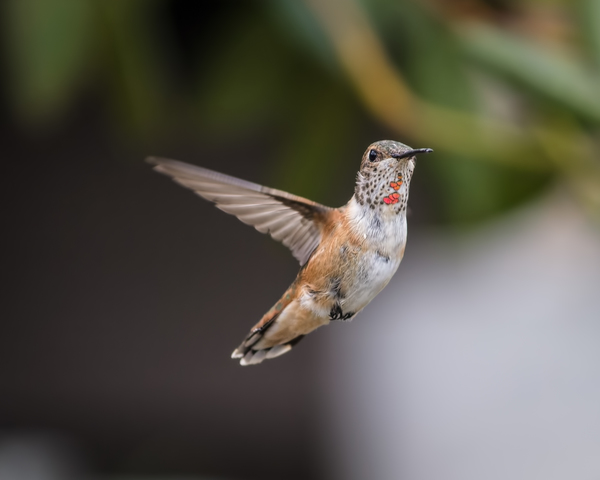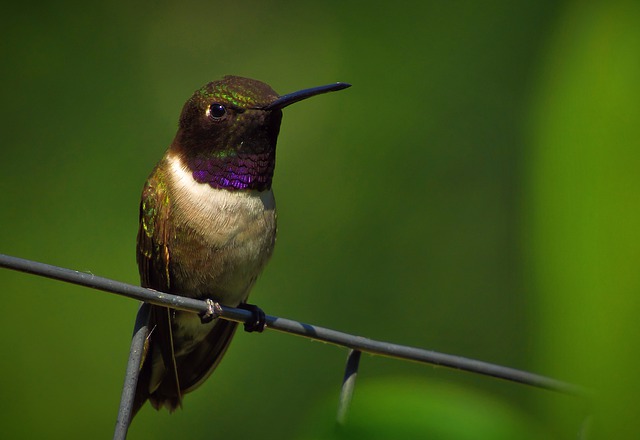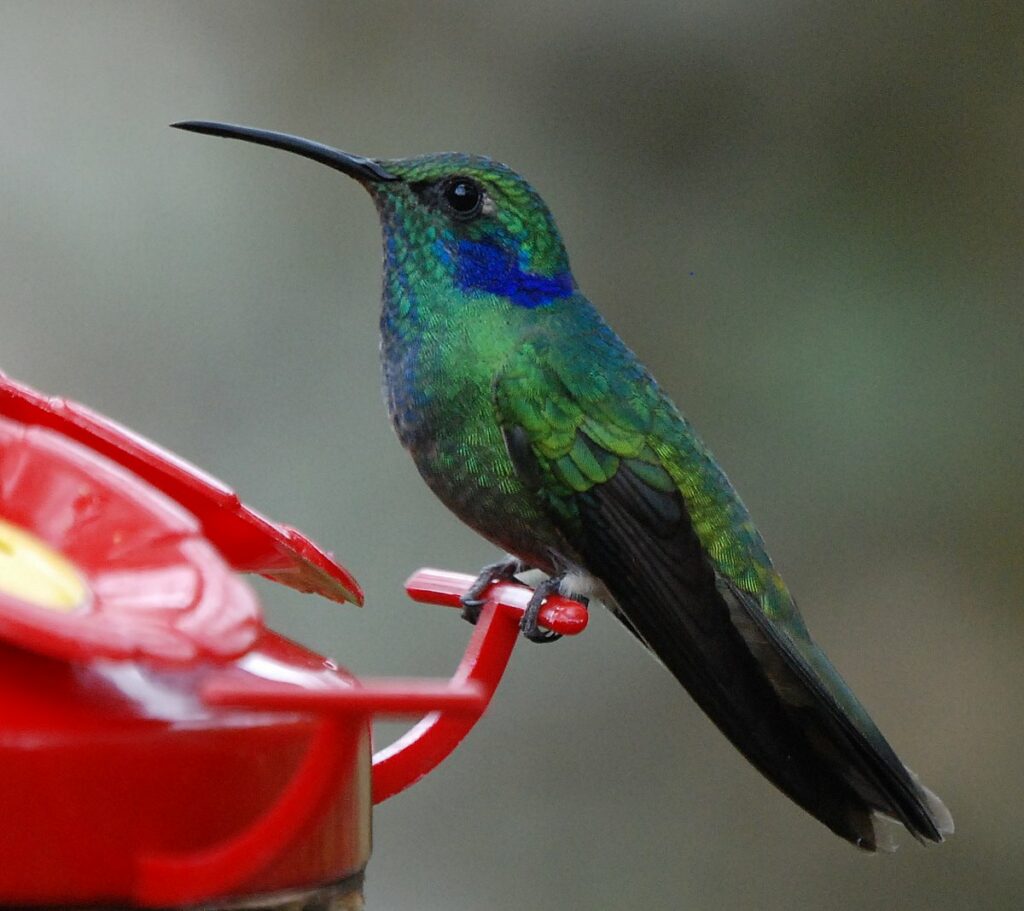As the spring breeze starts to warm up the air and flowers begin to bloom, you may spot a flash of color and movement in your backyard.
Hovering in mid-air with their wings beating at a rapid pace, hummingbirds are among the most fascinating birds to observe.
While Kentucky is not typically known for its hummingbird population, the state is home to five unique types of these small, yet mighty birds.
So, if you’re a bird enthusiast or simply curious about these charming creatures, let’s dive into the five types of hummingbirds that call Kentucky their home.
Get ready to be amazed by their beauty and unique characteristics!
| Image | |
|---|---|
 | Rufous Hummingbird |
 | Ruby-Throated Hummingbird |
 | Anna's Hummingbird |
 | Mexican Violetear |
 | Black-chinned Hummingbird |
Types of Hummingbirds in Kentucky
1. Rufous Hummingbird

Rarely seen outside of their native range, Rufous Hummingbirds have recently been sighted across Kentucky throughout the winter.
Between August and April, the state has the most sightings of these birds.
In addition to having a vibrant orange tummy and rear, the adult Rufous Hummingbird possesses a dazzling red throat.
Females have a rusty-colored flank, yellowish-brown backs, and a white abdomen.
When compared to their size, Rufous Hummingbirds are among the greatest migration distances.
They typically spend the summertime nesting season north of Alaska and Canada and wintertime around Mexico and the Gulf Coast.
In the springtime, Rufous Specie flies up the Pacific Coast, and during the autumn season, they migrate towards the Rocky Mountains.
Rufous Hummingbirds start their yearly spring season migration in January, and by mid-April, most of them have made it to Alaska.
The months of August and September are the peak of the autumn migration, which concludes in the month of October.
Scientists have reported that Rufous Birds are starting their yearly migration towards the north earlier and are going deeper inland as a result of this trend.
Typically, Rufous Hummingbirds consume nectar from tubular bright flowers, but they also eat small flies like insects, midges, and gnats.
They construct their nests high in trees, utilizing plant down for insulation and spider webs for structure.
They produce a clutch of two to three small whitish eggs, each measuring approximately 0.6 inches.
Alpine grasslands and evergreen trees are their natural environment.
They are highly antagonistic and may chase away larger hummingbirds or regular inhabitants if they get too close.
Throughout the migration, they don’t stick around for long, but if given the opportunity, they will drive away most other hummingbirds.
2. Ruby-Throated Hummingbird

Nineteen percent of all Kentucky bird checklists received during the summer include the Ruby-throated Hummingbird as the most often seen hummingbird throughout the state.
From April through November, they reproduce throughout the state, and in the wintertime, they fly south.
The male Ruby-throated Hummingbirds possess a gray-white upperside and an elegant red neck.
Green on top and white below, with brown sides and crowns, Ruby-throated female Hummingbirds have a distinctive green neck.
As far as we know, this bird is the sole hummingbird that breeds across the eastern part of North America.
To spend the winter months, they migrate even farther towards the south, toward Central America.
Some pass through the Gulf of Mexico, and there are others go along the Texas coastline.
Breeding season for the ruby-throated bird begins in southern Canada and the southern United States during February and might not start in Canada and the northern United States till May.
Males may showcase as much as two weeks before females in the springtime.
During the months of July and October, Ruby-throated Hummingbirds begin their annual migration south, congregating near the Texas Gulf Coast in September before continuing to their wintering grounds.
These tiny birds go from flower to flower in search of nectar, or they swoop down from the sky to pluck insects from the air or off of spider webs.
They move along a nest, sometimes stopping to stay on a branch; however, their legs are too short to walk.
The ideal locations to look for them throughout the summertime are flower yards and the outskirts of wooded areas.
They also often visit urban nectar feeders.
The male Ruby-throated Specie has been known to defend its feeders and blooms with violent behavior.
After breeding, males often leave the area by early September.
The nests of female ruby-throated thrushes are built from thin branches and are lined with a mixture of down from thistle and dandelion plants as well as spider silk.
3. Anna’s Hummingbird

Anna’s Hummingbirds are an introduced species in the state of Kentucky, and they have only been sighted in Jefferson in the years 2021 and 2022.
Tiny birds of the genus Anna are known for their predominant dark gray, green, and plumage.
The man’s neck and head are glowing with pink coloration.
The female possesses a grey neck with sporadic red spots.
When it comes to hummingbirds, Anna’s are among the most common along the Pacific Coast, and they don’t migrate like most other species.
Over the course of the year, you may find them from Baja, California, through British Columbia.
Although, certain avian species may go south from their Arctic wintering grounds.
Anna’s hummingbirds are typically seen in public parks and suburban gardens with many nectar feeders and flowering plants, although they may also be spotted among scrub and savannah.
Anna’s Hummingbirds get their nutrients from multiple sources, including tree sap, insects, nectar, and spiders of a suitable size.
Diplaucus, Nicotiana, Eucalyptus, Silena, Agave, Castilleja, Arctostaphylos, Ribes, and nectar feeders all provide nectar.
Anna’s Hummingbirds build their nests 5 to 22 feet up in trees, have two to three broods a year, and are entirely female.
During the courtship process, the males will make magnificent dive displays, soaring to heights of up to 135 feet before tumbling to the ground with a scream of their tail plumes.
4. Mexican Violetear

Mexican Violetears are incidental species throughout Kentucky.
They have only been seen once, in 1999, in the town of Taylor Mill, making their appearance in the state an exceptionally unusual occurrence.
Metallic green in color, Mexican Violetears are approximately the size of other medium-sized hummingbirds and have violet spots on the sides of their heads as well as on their chests.
Breeding grounds for Mexican Violetears include the forested regions of Central America, Mexico, and even as far south as Nicaragua; however, the species has been seen in the mountainous regions of Venezuela and Bolivia.
Additionally, non-breeding Mexican Violetears might cross the border into southern and central Texas throughout the United States and spend the winter there.
5. Black-chinned Hummingbird

Throughout Kentucky, the Black-chinned Hummingbird is considered an incidental species, and the last time one was seen there was in the year 2016.
The upper parts of black-chinned Hummingbirds have a dull metallic greenish color, while the underparts are a grayish-white color.
The males possess a black neck with a thin vivid violet base, while the females possess a light neck and white ends on the tail plumage.
Males possess a black neck with a narrow brilliant purple base.
Breeding season for black-chinned Hummingbirds occurs mostly in the interior regions of western states throughout the summertime, stretching from Baja California to British Columbia.
They might travel to mountainous and hilly locations with an abundance of flowers once they have finished mating and then migrate towards the Gulf Coast, western Mexico, and southern California during the winter.
The months of March and October are often the times when Black-chinned Hummingbirds migrate.
They consume spiders, honey, and other tiny insects.
When feeding on nectar, their tongues are capable of licking anywhere from 14 to 18 times a second.
The spider silk and plant material that are used to keep the nests of black-chinned birds together are used to construct the nests, and the females deposit two very little white eggs that are just around 0.1 inches in length.
It is not uncommon to see a Black-chinned Hummingbird perched on a little, bare limb at the very apex of a dead tree.
These birds frequently remain in the same place year after year.
Rivers and Canyons, as well as shaded oak groves, are good places to look for them.
Conclusion
In conclusion, Kentucky may not be the first state that comes to mind when thinking of hummingbirds, but it is certainly home to some unique and remarkable species.
From the dazzling Ruby-throated Hummingbird to the tiny and elusive Rufous Hummingbird, each type has its own charm and characteristics that make it a delight to observe.
As we move into the warmer months, keep an eye out for these incredible birds in your backyard or local park.
Whether you’re an experienced birder or just starting out, the hummingbirds of Kentucky are sure to leave you in awe.
FAQ
What is the most common type of hummingbird in Kentucky?
The Ruby-throated Hummingbird is the most common type of hummingbird in Kentucky. It is also the only hummingbird species that breeds east of the Mississippi River.
When is the best time to spot hummingbirds in Kentucky?
Hummingbirds typically migrate to Kentucky from late March to early April, and stay until late September to early October. The best time to spot them is during their migration periods, as well as during the summer months when they are actively feeding and breeding.
What type of food do hummingbirds in Kentucky prefer?
Hummingbirds in Kentucky feed primarily on nectar from flowers, as well as insects and spiders for protein. You can attract hummingbirds to your backyard by planting nectar-rich flowers and putting up feeders filled with a solution of four parts water to one part sugar.
Are hummingbirds in Kentucky endangered?
While none of the hummingbird species found in Kentucky are currently considered endangered, some, such as the Rufous Hummingbird, are experiencing population declines due to habitat loss and other factors. It is important to protect and preserve the habitats that these birds rely on for their survival.
Last Updated on March 22, 2023 by Lily Aldrin

I have several black chined humming birds at my feeder this year!! The males appear to be more aggressive than the Ruby red throat males!!!
This is the first year I’ve really noticed them!! He fights off other hummers from three separate feeders!! I live in deep wooded area in Albany Kentucky, Clinton county, about 10 miles from Tennessee border. I’ve had feeders up here for seven yrs. And never noticed the black chin here before this spring 2023!!! 😀